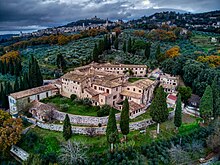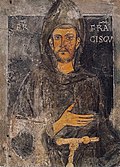Poor Clares
The Poor Clares, officially the Order of Saint Clare (
The Poor Clares follow the
Foundation and rule

The Poor Clares were founded by

By 1216, Francis was able to offer Clare and her companions a monastery adjoining the chapel of San Damiano where she became abbess. Clare's mother, two of her sisters and some other wealthy women from Florence soon joined her new order. Clare dedicated her order to the strict principles of Francis, setting a rule of extreme poverty far more severe than that of any female order of the time.[3] Clare's determination that her order not be wealthy or own property, and that the nuns live entirely from alms given by local people, was initially protected by the papal bull Privilegium paupertatis, issued by Pope Innocent III.[4] By this time the order had grown to number three monasteries.
Spread of the order
The movement quickly spread, though in a somewhat disorganized fashion, with several monasteries of women devoted to the Franciscan ideal springing up elsewhere in Northern Italy. At this point Ugolino, Cardinal Bishop of
Clare herself resisted the Ugolino Rule, since it did not closely enough follow the ideal of complete poverty advocated by Francis. On 9 August 1253, she managed to obtain a papal bull, Solet annuere, establishing a rule of her own, more closely following that of the friars, which forbade the possession of property either individually or as a community. Originally applying only to Clare's community at San Damiano, this rule was also adopted by many monasteries.[4] Communities that followed this stricter rule were fewer in number than the followers of the rule formulated by Cardinal Ugolino, and became known simply as "Poor Clares" (PC) or Primitives. Many sources before 1263 refer to them as Damianites (after San Damiano).[6]
The situation was further complicated a century later when
The spread of the order began in 1218 when a monastery was founded in
Europe
United Kingdom
The first Poor Clare monastery in England was founded in 1286 in
After the
Following Catholic emancipation in the first half of the 19th century, other Poor Clares came to the United Kingdom,[9] eventually establishing communities in, e.g., Notting Hill (1857, which was forced to relocate by the local council in the 1960s, and settled in the village of Arkley in 1969),[10] Woodchester (1860–2011), Levenshulme (1863),[11] Much Birch (1880), Arundel (1886), Lynton (founded from Rennes, France, 1904–2010s), Woodford Green (1920–1969), York (1865–2015)[12] and Nottingham (1927-2023).[13][14]
The community in Luton was founded in 1976 to meet a shortage of teachers for local Catholic schools. It was originally based at 18 London Road in a large Edwardian house. In 1996, the community refocused on a ministry of social work and prayer, and moved to a smaller, modern home at Abigail Close, Wardown Park.[15]
Ireland
In Ireland there are seven monasteries of the Colettine Observance. The community with the oldest historical roots is the monastery on Nuns' Island in Galway, which traces its history back to the monastery in Gravelines. The community has a rare book collection which is the most comprehensive single collection of early-modern Clarissan material in English in the world.[16]
Originally a separate community of
Later monasteries were founded in 1906 in both
There is Poor Clares monastery in Faughart, County Louth.[19]
Continental Europe

Currently there are communities of Colettine Poor Clares in Bruges, Belgium, as well as in Eindhoven, the Netherlands, and in Larvik, Norway. There are several monasteries in Hungary, Lithuania and Poland of the Urbanist and Capuchin Observances.
There are notable Clarissine churches in Bamberg, Bratislava, Brixen, and Nuremberg. There also is a small community in Münster, Germany, and a Capuchin monastery in Sigolsheim, France.
The last six Poor Clare nuns from a convent in Belgium were able to sell their convent by selling luxury vehicles, and move to the South of France.[20]
Americas
United States
After an abortive attempt to establish the order in the United States in the early 1800s by three nuns who were refugees of
A small group of Colettine nuns arrived from
Currently[
Canada
There are three monasteries of the order in Canada:
Latin America

There have been monasteries of the order in Mexico since colonial days. The Capuchin nuns alone number some 1,350 living in 73 different monasteries around the country.[38]
A monastery was founded in Huehuetenango, Guatemala, by nuns from the community in Memphis, Tennessee, in November 1981, in the early days of a bloody civil war which ravaged that country; as of 2011, it consisted of seven nuns; five Guatemalans and two Salvadorans.[39]
Asia

The Poor Clares were massacred at
Philippines
The Poor Clare in the
Together with the Alcantarine Friars who came to the Philippines in 1578 and strive to live the ideals of Francis of Assisi in a very rigorous way, the Poor Clare sisters also professed the Rule and life of Clare of Assisi. They heightened their witnessing of the "privilege of poverty" of Clare by not having a permanent income but rather opened their gates of the Divine Providence through alms and the generosity of the people.
Their Monastery in Intramuros was severely devastated by an earthquake. However, through the efforts of the people around, it was rebuilt and has a larger space compared to the former monastery. During the war for independence in the year 1945, the monastery was destroyed again and the sisters were forced to evacuate the place. For the meantime, they were sheltered at the Minor Seminary of the Franciscans in San Francisco del Monte, Quezon City for 5 years. The present location of the Monastery is at Aurora Boulevard, C5, Katipunan, Quezon City. Because of the zeal for the contemplative life, the founder's cause is ongoing for beatification.
Apart from the said monastery, it also expand its presence from the different parts of the country. The country has 27 monasteries in total:
, Kalinga (2017). The Poor Clare Monastery in Palawan province is founded by the Monastery from China.Furthermore, their expansion does not only limit in the Philippine archipelago but also helped the aging communities in
There are also monastery from Kiryū, Gunma, Japan, which was founded from the monastery in Boston in 1965.[40]
Connections with television
- In 1958, Saint Clare was declared the patron saint of television by the Catholic Church.
- The Eternal Word Television Network (EWTN) is operated by the Poor Clares of Perpetual Adoration in Alabama. It is privately owned.
- In June and July 2006, The Convent,[41]in which four women were admitted to a Poor Clare monastery in southern England, for a period of six weeks, to observe the life.
See also
- Colettine Poor Clares
- Capuchin Poor Clares
- Poor Clares, Unreformed
- Poor Clares of Perpetual Adoration
Notes and references
- ^ "Poor Clare Sisters". Retrieved 9 December 2016.
- ^ Michael Walsh (ed.). Butler's lives of the Saints, Burns and Oates (1991) p. 246.
- ^ a b Farmer, David (ed.) Oxford Dictionary of Saints, Oxford University Press (1997), p. 103
- ^ a b c d "Poor Clares". The Catholic Encyclopedia, New Advent. Retrieved 10 November 2009.
- ^ a b Encyclopædia Britannica, 2007, Vol.9. p. 603
- ^ Bert Roest, Order and Disorder: The Poor Clares between Foundation and Reform (Brill, 2013), p. 2.
- ^ a b Queen Isabella (c.1295/1358) and the Greyfriars: An example of royal patronage based on her accounts for 1357/1358, Michael Robson, Franciscan Studies, Vol. 65 (2007), 328.
- ^ a b c "History of the Poor Clare Order in Britain - The Poor Clare Monastery, Hereford". Retrieved 9 December 2016.
- ^ McKeown, Paul. "Franciscans and Poor Clares(UK) - Links to Franciscans and Poor Clares". Retrieved 9 December 2016.
- ^ "Arkley Poor Clare Monastery". Archived from the original on 23 January 2011.
- ^ "Manchester (Levenshulme) – St Mary of the Angels and St Clare". Retrieved 26 November 2022.
- ^ Lewis, Stephen (13 February 2015). "Convent life on the quiet". York Press. Retrieved 21 April 2020.
- ^ "Community of Poor Clare Colettines, Bulwell in Nottingham". Retrieved 26 November 2022.
- ^ Zagnat, Olimpia (3 May 2023). "'Our loss' as nuns leave city after failing to raise money for new monastery". NottinghamshireLive. Retrieved 15 August 2023.
- ^ "Luton". Sisters of St Clare.
- ^ Goodrich, Jaime.(2021). “The Rare Books of the Galway Poor Clares.” Library 22.4:: 498–522.
- ^ Team, Marek Mazur &. "Poor Clares Galway - Ireland". Archived from the original on 2 November 2016. Retrieved 9 December 2016.
- ^ "Poor Clares of Drumshanbo "History"". Archived from the original on 4 March 2016. Retrieved 2 December 2011.
- ^ Life is beautiful for the Poor Clare sisters by Olivia Ryan, The Argus, 9 July 2014.
- ^ Goldsmith, Charles (6 April 1990). "The adviser to aging nuns who sold their convent..." UPI.
- ^ "Home - Poor Clare Sisters of Omaha". Retrieved 9 December 2016.
- ^ "Poor Clare Monastery of Mary, Mother of the Church". Archived from the original on 3 December 2013. Retrieved 9 December 2016.
- ^ "Home". 3 December 2009. Archived from the original on 3 December 2009. Retrieved 21 April 2020.
- ^ "Poor Clare Nuns Belleville - Who We Are Today". Retrieved 9 December 2016.
- ^ "Poor Clares of Chicago -- Home Page". Retrieved 9 December 2016.
- ^ "Poor Clares Cincinnati". Retrieved 9 December 2016.
- ^ "Poor Clare Sisters of Evansville, Indiana, the Second Order of St. Francis". Retrieved 9 December 2016.
- ^ "Community of Poor Clare Nuns of Kokomo IN, Inc". Community of Poor Clare Nuns of Kokomo IN, Inc. Retrieved 22 August 2022.
- ^ "Capuchins,, Memphis". poorclare.org. Retrieved 21 April 2020.
- ^ "Bethlehem Monastery - Barhamsville, Virginia". Retrieved 9 December 2016.
- ^ "Poor Clare PA – Langhorne, PA". Retrieved 9 December 2016.
- ^ "Clare Colettine Nuns, Rockford, Illinois".
- ^ "Poor Clares of Roswell". Retrieved 9 December 2016.
- ^ "Called by Joy - The Poor Clare Sisters of Spokane, Washington". Retrieved 9 December 2016.
- ^ "Welcome". Poor Clares of Perpetual Adoration, Washington, DC. Retrieved 9 December 2016.
- ^ "Dwelling For The Lord". Poor Clares of New York. Archived from the original on 8 December 2013. Retrieved 11 August 2013.
- ^ ISBN 978-2-7468-2569-7Published by Editions du Signe, France
- ^ "Capuchin". www.capuchins.org. Retrieved 21 April 2020.
- ^ Hermanas Clarisas "Sobre Nosotras" [1](in Spanish)
- ^ "Poor Clares, Japan". poorclare.org. Retrieved 21 April 2020.
- ^ "Poor Clares Arundel". www.poorclaresarundel.org. Archived from the original on 19 November 2009.
External links
- Poor Clares Official U.S. website
- The Catholic Encyclopedia: The Poor Clares
- Prayer for Poor Clare and Franciscan Vocations
- The Convent television series
- . Encyclopædia Britannica (11th ed.). 1911.


